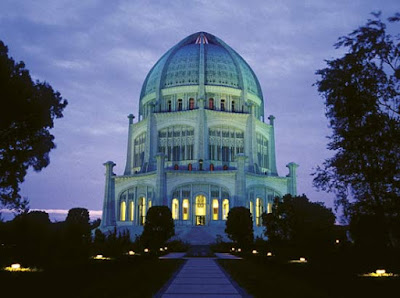
[This blog focuses on the The Baha'i temple in Chicago]. What an absolutely gorgeous temple! The pictures on the website show it's extensive beauty. Looking through the pictures makes me want to go and witness for myself it's overwhelming splendor. I love all of the assets that is part of the website; there is so much to learn . If someone was to ask me what the Baha'i religion is, I would send them here.
I love that they have a page titled "What we believe"; this is great for anyone unaware of this faith. Since the Baha'i faith is newer than most other religions that people come upon, it's really helpful to have this kind of page to look at. There are even subsections to this page such as "Symbols" which shows and defines the symbols that belong to the Baha'i s. Another pages goes into how to "Be a Baha'i". In this part they explain such areas as moral principles, personal behaviors, and teachings that one must live under to be a Baha'i. Another part that is really cool about this website is the search engine: if you put in anything that you'd like to know about the religion into this engine, it finds it either within the website or through others which is a great addition!
I am presently listening to the "audio tour". This is really interesting because it doesn't start right off the bat talking about the religious structure it's self but instead about beautiful Chicago area surrounding it. My Dad is an architect and has told me about this magnificent work before. I didn't know that it was voted one of the "7 wonders on Illinois" which is quite fitting in my opinion. I love that in this tour they explain that visiting this temple isn't just for members of the Baha'i religion but for everyone to come and "experience a jolt of spiritual energy or lift a burden for the moment" (awesome way they phrased that!)This audio tour is also a great "draw" for tourists because it explains all of the options you have once you get there: there are videos to watch, free literature, or a guided tour. They even give a little background for those who are looking into coming so that they know a little about what they will see before they arrive at the temple. This temple is "not just for the Baha'i s".. This statement to me is very telling of the religion, they seem to be very open to all people and they don't believe in pushing some out but instead accepting and education many of their beliefs. The main purpose the Baha'i temple in Chicago is striving to provide an "oasis of serenity for all of the world. I also loved that the audio tour finished with a choir singing which was gorgeous.
I just talked to my mom and she told me that her trip with my dad to the Baha'i Temple was absolutely gorgeous. This summer, possibly with my parents and brother, I really hope to go to the Baha'i temple and gaze up at the intricate ceilings, witness the elaborate architecture, and observe the vibrant colors of the gardens too.

http://www.bahai.us/bahai-temple





















